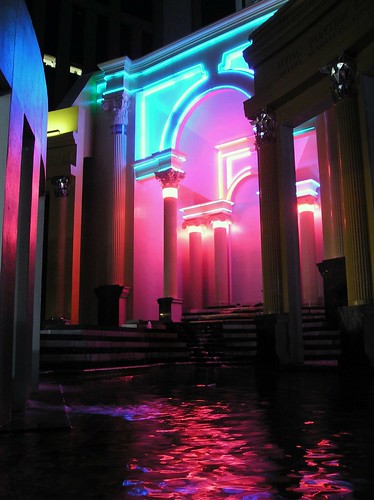So, uh, check out this recent post from a great music blog entitled 20jazzfunkgreats. It describes each track in mind-boggling detail. Each song is translated from music to words with astonishing accuracy. The experience of reading and hearing the music is an interesting one. I'm not sure if the word is "enhanced," but it is definitely a unique way of hearing a song and artist for the first time. It is not a new thing, these translations from word to song, song to word, song to building, building to word, word to building, song to song, building to building, and building to song.
Could we listen to music which would further the experience and character of a space? Can these songs "code" the space? Can music taste be translated into a building? I guess a nightclub is sort of the jumping off point for such exploration.
But there are principles which also translate from each of these scenarios. I have wondered what would happen if each building had a song that was grouped with it. For the first experimental pairing, I have chosen the holy grail of mockitecture, Charles Moore's Piazza d'Italia (1976-9), and The Isley Brothers' 1974 Classic, Live It Up...

I could honestly see the Soul Train set (which is beautiful) being replaced with the Piazza d'Italia. In fact, I wish that would happen. But I digress. The Soul Train Set is worth noting, because it transformed over time, like architecture. Here is a video from the 80's, with Prince's 1999 (1983) and Peter Eisenman's Wexner Center (1983). This song/building has an eerie resemblance. It is almost as if the original idea of translation from Prince to Wexner happened behind the scenes in some shadow government's thinktank. These are the ideas I think of when listening to the words of 1999 and looking at the Wexner Center. Peter Eisenman was at least listening to 1999 when he designed the Wexner. The entire song has simliar references to the ideas of Eisenman. Have a listen/look...

I can just see Eisenman singing those lyrics while desinging this building, or any of his others. "I was dreamin' when I wrote this, so excuse me if I go astray" ba ba ba da ba "Tonight we're gonna party like its 1999" ba ba ba da ba... The quasi-apocalyptic skepticism runs so deep! It is funny now, because it's a joke to us, but in 1983, this was the stuff. In all honesty, I think that that says something about Eisenman, that his buildings fit so well with the year 1983. Or maybe that's what it means to be dated. I don't really know.
The next pair is OMA's RAK Convention Center (2006-Present) and Cryptonites' Remix of FutureCop!'s "NASA"(2008) In today's music, the idea of a remix is alot like a historical reference in architecture. They address the same kind of memory-reinterpretation-identity sorts of ideas. In the case of the next building/song, the relationship is two-fold.

1. Appropriation/reInterpretation of an object... the OMA project takes the deathstar, an image from the movie Star Wars, and makes it into a building. This reference is nostalgic, and people relate to nostalgia. Whether in their homes of in the streets, nostalgia never loses its power.
2. References to the past. Much of today's music is derived from the 80's. FutureCop! has heavy influence from the eighties and the techniques(synths) and philosophies(if it sounds good, play it). Even the bands' marketing plays on nostalgia. The OMA project directly references not only the object from the 80's, but also the formalist ideology of architecture near that time. I think the shape of that building also points out some things about context, both physical and cultural, but that is another post. (Also note the mini-van in the above rendering).
6 comments:
bravo!!!
Wow I really like the last song/image combo...right around 1:00 everything makes sense. Also, no other music video can ever come close to replicating the background stage of "Soul Train."
Very good! Unfortunately I think that Rem's is the inferior piece of nostalgia, lacking the hyper-jerky nightclub flashback quality of Futurecop. Perhaps you could do a retroactive (ho ho) pairing of his Beverley Hills Prada store and Harold Faltermeyer's peerless Axel F?
Charles,
Thank you for your comment. Isn't it a shame that most/all architecture lack the hyper-jerky nightclub flashback quality of Futurecop?
Yes, now that you mention it I do.
Or, indeed, the haunting digital emptiness of Harold Faltermeyer.
If
'architecture is frozen music'
then
music is melting architecture
(or at least evanescent)
Post a Comment